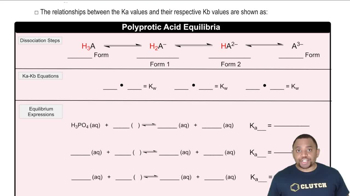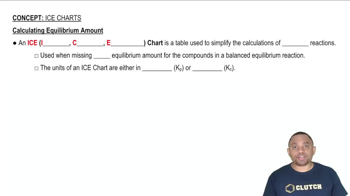In which of these solutions will HNO2 ionize less than it does in pure water? a. 0.10 M NaCl b. 0.10 M KNO3 c. 0.10 M NaOH d. 0.10 M NaNO2
Ch.17 - Aqueous Ionic Equilibrium
Chapter 17, Problem 29a
Solve an equilibrium problem (using an ICE table) to calculate the pH of each solution. a. a solution that is 0.20 M in HCHO2 and 0.15 M in NaCHO2
 Verified step by step guidance
Verified step by step guidance1
Start by identifying the weak acid and its conjugate base in the solution. Here, HCHO2 (formic acid) is the weak acid, and NaCHO2 provides the conjugate base, CHO2^-.
Write the equilibrium expression for the dissociation of the weak acid: HCHO2 \rightleftharpoons H^+ + CHO2^-.
Set up an ICE table (Initial, Change, Equilibrium) to track the concentrations of each species. Initially, [HCHO2] = 0.20 M, [CHO2^-] = 0.15 M, and [H^+] = 0.
Define the change in concentration using a variable, x, where x is the amount of HCHO2 that dissociates: [HCHO2] = 0.20 - x, [CHO2^-] = 0.15 + x, [H^+] = x.
Use the acid dissociation constant (Ka) for formic acid to set up the equation: Ka = \frac{x(0.15 + x)}{0.20 - x}. Solve for x to find [H^+], then calculate pH using pH = -\log[H^+].

Verified video answer for a similar problem:
This video solution was recommended by our tutors as helpful for the problem above.
Video duration:
3mWas this helpful?
Key Concepts
Here are the essential concepts you must grasp in order to answer the question correctly.
Acid-Base Equilibrium
Acid-base equilibrium refers to the state where the concentrations of acids and their conjugate bases in a solution remain constant over time. In this context, the weak acid HCHO2 (formic acid) and its conjugate base NaCHO2 (sodium formate) establish an equilibrium that can be analyzed using the Henderson-Hasselbalch equation or an ICE table to determine the pH of the solution.
Recommended video:
Guided course

Triprotic Acid Equilibrium
ICE Table
An ICE table (Initial, Change, Equilibrium) is a tool used to organize the concentrations of reactants and products in a chemical reaction at different stages. For equilibrium problems, it helps to track the initial concentrations, the changes that occur as the system reaches equilibrium, and the final concentrations, which are essential for calculating pH in acid-base reactions.
Recommended video:
Guided course

ICE Charts and Equilibrium Amount
Henderson-Hasselbalch Equation
The Henderson-Hasselbalch equation is a mathematical formula used to calculate the pH of a buffer solution. It is expressed as pH = pKa + log([A-]/[HA]), where [A-] is the concentration of the conjugate base and [HA] is the concentration of the weak acid. This equation is particularly useful for solutions containing both a weak acid and its conjugate base, allowing for quick pH estimations.
Recommended video:
Guided course

Henderson-Hasselbalch Equation
Related Practice
Textbook Question
2
views
Textbook Question
A formic acid solution has a pH of 3.25. Which of these substances will raise the pH of the solution upon addition? Explain your answer. a. HCl b. NaBr c. NaCHO2 d. KCl
Textbook Question
Solve an equilibrium problem (using an ICE table) to calculate the pH of each solution. b. a solution that is 0.16 M in NH3 and 0.22 M in NH4Cl
Textbook Question
Solve an equilibrium problem (using an ICE table) to calculate the pH of each solution. a. a solution that is 0.195 M in HC2H3O2 and 0.125 M in KC2H3O2 b. a solution that is 0.255 M in CH3NH2 and 0.135 M in CH3NH3Br
Textbook Question
Calculate the percent ionization of a 0.15 M benzoic acid solution in pure water and in a solution containing 0.10 M sodium benzoate. Why does the percent ionization differ significantly in the two solutions?
